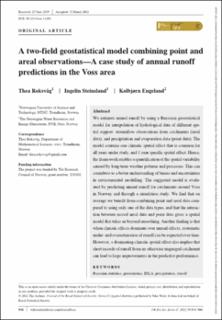| dc.contributor.author | Roksvåg, Thea | |
| dc.contributor.author | Steinsland, Ingelin | |
| dc.contributor.author | Engeland, Kolbjørn | |
| dc.date.accessioned | 2022-11-16T10:19:41Z | |
| dc.date.available | 2022-11-16T10:19:41Z | |
| dc.date.created | 2021-05-18T17:44:27Z | |
| dc.date.issued | 2021 | |
| dc.identifier.citation | The Journal of the Royal Statistical Society, Series C (Applied Statistics). 2021, . | en_US |
| dc.identifier.issn | 0035-9254 | |
| dc.identifier.uri | https://hdl.handle.net/11250/3032115 | |
| dc.description.abstract | We estimate annual runoff by using a Bayesian geostatistical model for interpolation of hydrological data of different spatial support: streamflow observations from catchments (areal data), and precipitation and evaporation data (point data). The model contains one climatic spatial effect that is common for all years under study, and 1 year specific spatial effect. Hence, the framework enables a quantification of the spatial variability caused by long-term weather patterns and processes. This can contribute to a better understanding of biases and uncertainties in environmental modelling. The suggested model is evaluated by predicting annual runoff for catchments around Voss in Norway and through a simulation study. We find that on average we benefit from combining point and areal data compared to using only one of the data types, and that the interaction between nested areal data and point data gives a spatial model that takes us beyond smoothing. Another finding is that when climatic effects dominate over annual effects, systematic under- and overestimation of runoff can be expected over time. However, a dominating climatic spatial effect also implies that short records of runoff from an otherwise ungauged catchment can lead to large improvements in the predictive performance. | en_US |
| dc.language.iso | eng | en_US |
| dc.publisher | Wiley | en_US |
| dc.rights | Navngivelse 4.0 Internasjonal | * |
| dc.rights.uri | http://creativecommons.org/licenses/by/4.0/deed.no | * |
| dc.title | Journal of the Royal Statistical Society: Series C (Applied Statistics) Journal of the Royal Statistical Society: Series C (Applied Statistics) ORIGINAL ARTICLE Open Access A two-field geostatistical model combining point and areal observations—A case study of annual runoff predictions in the Voss area | en_US |
| dc.type | Peer reviewed | en_US |
| dc.type | Journal article | en_US |
| dc.description.version | publishedVersion | en_US |
| dc.source.pagenumber | 27 | en_US |
| dc.source.journal | The Journal of the Royal Statistical Society, Series C (Applied Statistics) | en_US |
| dc.identifier.doi | 10.1111/rssc.12492 | |
| dc.identifier.cristin | 1910589 | |
| dc.relation.project | Norges forskningsråd: 250362 | en_US |
| cristin.ispublished | true | |
| cristin.fulltext | postprint | |
| cristin.qualitycode | 2 | |

